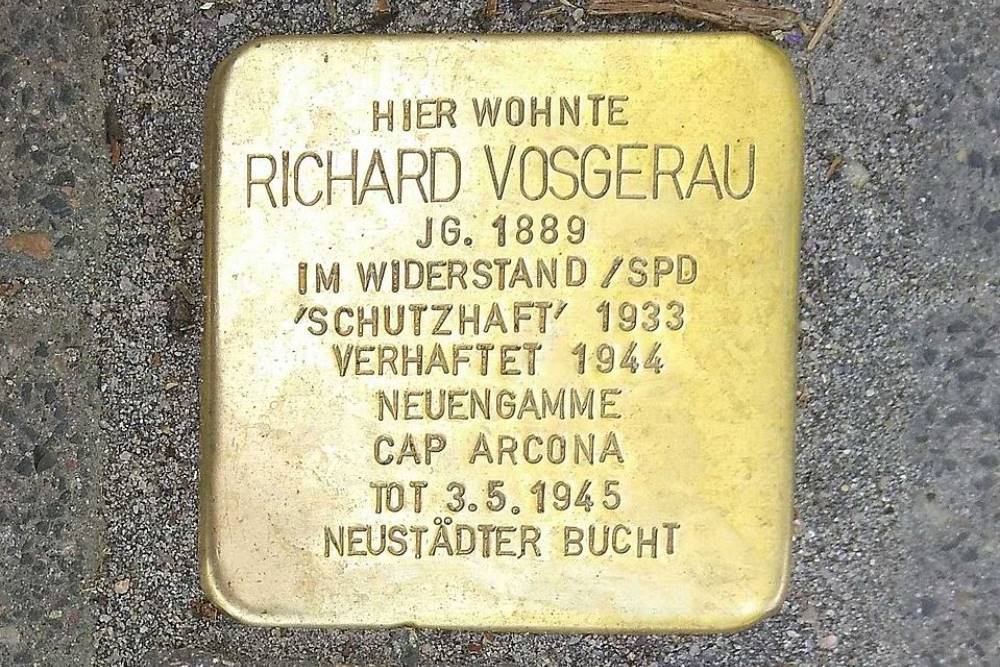Stumbling Stone Hasenheide 5
This small brass memorial plaque (Stolperstein, struikelsteen, or stumbling stone) commemorates:
* Richard Vosgerau, born 1889, in Resistance /SPD, "Protective custody" 1933, arrested 1944, Neuengamme, Cap Arcona, dead 3 May 1945, Neustädter Bucht.
Richard Vosgerau was born in Eckernförde. Richard attended elementary school and then did a baker’s apprenticeship in Kiel. He worked at the imperial shipyard in Kiel and joined the union and the SPD (Socialdemokratische Partei Deutschlands). He married Maria Soltau in Borby; they had at least three sons (and possbily other children).
In 1914, he became the chairman of the Eckernförde SPD, the union secretary, and from 1929 the mayor / municipal councilor of Borby. In 1930/31 he initiated the renovation and expansion of the elementary school in Borby (a town which later was merged into Eckernförde).
After protesting against the Nazi ideology, Richard Vosgerau was put into "protective custody" from April to November 1933, under the false accusation that he had stolen 40,000 Reichsmarks from the union. He was imprisoned in Rendsburg for a while. After a long period of unemployment, he worked as representative and district manager for a life insurance company starting in 1935. The Nazis continued to harrass him. At the beginning of WW2, his house in Kiel was bombed and two sons were killed in the war. He and Maria moved back to Borby to a property on Hasenheide that Maria had inherited.
After the assassination attempt on Hitler on 20 July 1944, Vosgerau (with his history of labor union leadership) was taken to Neuengamme concentration camp. Both his wife and a son tried to get him released. After Neuengamme was liberated, his family, friends, and colleagues waited in vain for his return. He probably died on the Cap Arcona. He was officially declared dead in 1949.
When the Nazis emptied the Neuengamme camp in April 1945 before the arrival of the Allies, thousands of prisoners were put on the Cap Arcona, a ship which became an overcrowded concentration camp with no food and no drinking water. The Cap Arcona and several other floating concentration camps were hidden in plain sight among other troop ships. With a goal of keeping the Germans from escaping by boat, the British bombed the ships in the harbor. Approximately 7,000 concentration camp prisoners died by fire or drowning, or were shot by Germans on the shore.
Four days later, the Germans signed an unconditional surrender of all German forces to the Allies.
The Richard-Vosgerau Schule in Eckernförde, which was named for Richard Vosgerau in May 1948, sponsored the installation of a stolperstein in his memory at this Hasenheide location in 2019. A plaque in his honor is at the entry to the school.
For more information and photos about the Cap Arcona, please see Floating concentration camps in the Bay of Lübeck.
"Stolpersteine" is an art project for Europe by Gunter Demnig to commemorate victims of National Socialism (Nazism). Stolpersteine (stumbling stones) are small, 10x10cm brass plaques placed in the pavement in front of the last voluntary residence of (mostly Jewish) victims who were murdered by the Nazis. Each plaque is engraved with the victim’s name, date of birth, and place (mostly a concentration camp) and date of death. By doing this, Gunter Demnig gives an individual memorial to each victim. One stone, one name, one person. He cites the Talmud: "A human being is forgotten only when his or her name is forgotten."
Do you have more information about this location? Inform us!




